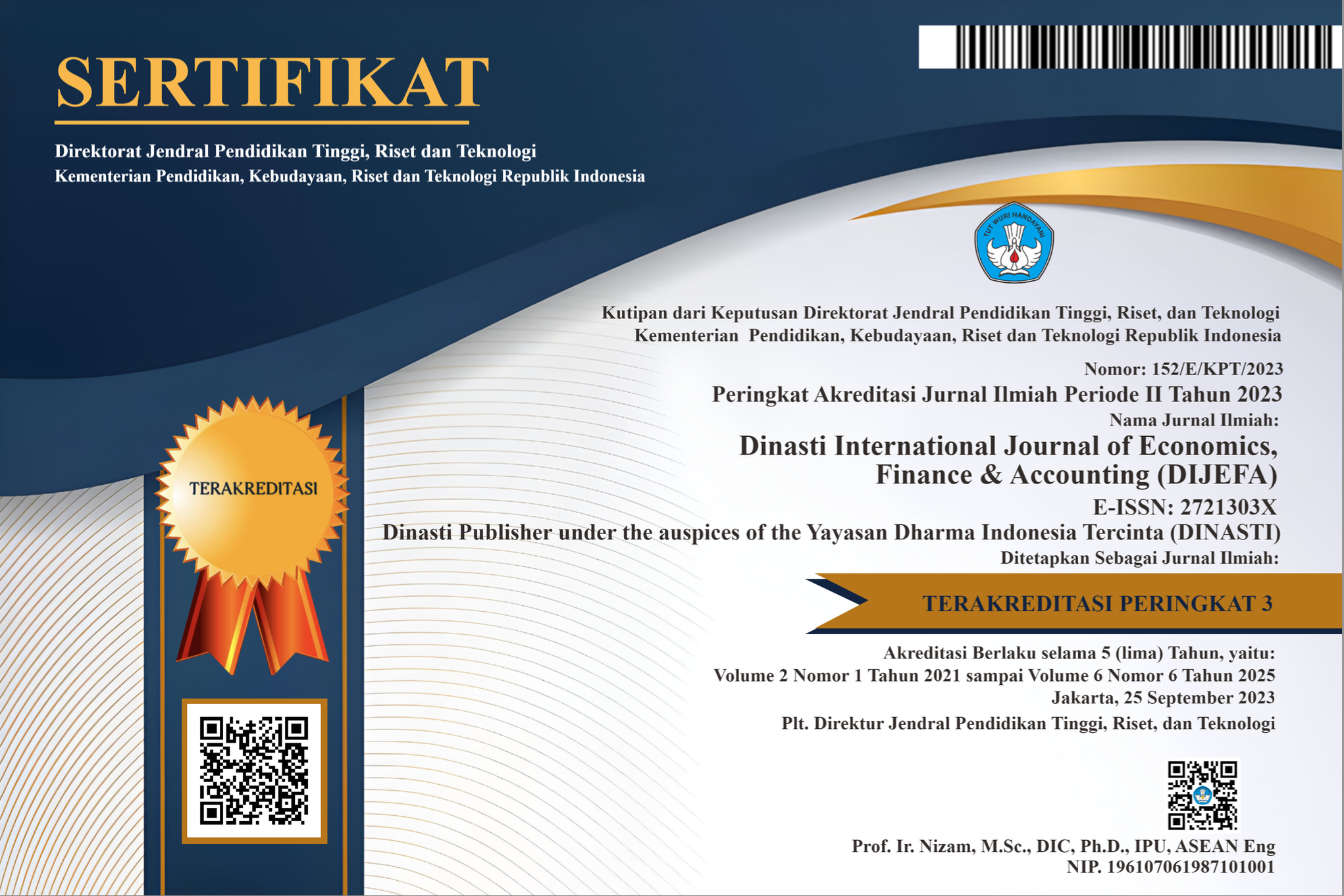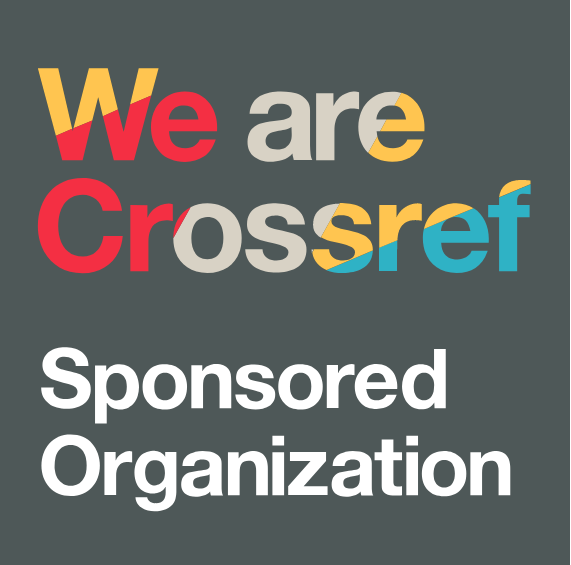The Influence of Intangible Assets, Financial Flexibility, and Human Capital on Sustainable Growth with Green Innovation as a Moderator
DOI:
https://doi.org/10.38035/dijefa.v6i2.4735Keywords:
intangible assets, financial flexibility, human capital, green innovation, sustainable growthAbstract
This study, titled "The Influence of Intangible Assets, Financial Flexibility, and Human Capital on Sustainable Growth with Green Innovation as a Moderator," aims to analyze the effects of intangible assets, financial flexibility, and human capital on sustainable growth within energy sector companies in Indonesia, with green innovation serving as a moderating variable. The research is driven by the challenges faced by the energy sector, such as climate change, resource scarcity, and the transition to renewable energy. A quantitative approach was applied, utilizing secondary data from financial reports of energy companies listed on the Indonesia Stock Exchange during the 2020–2023 period, analyzed using STATA software. The findings indicate that intangible assets have no significant effect on sustainable growth, whereas financial flexibility and human capital show positive and significant impacts. Additionally, green innovation strengthens the relationship between the three variables and sustainable growth. This research is expected to provide valuable insights for the development of sustainable business strategies in the energy sector.
References
Agustia, D., Sawarjuwono, T., & Dianawati, W. (2019). The Mediating Effect of Environmental Management Accounting on Green Innovation - Firm Value Relationship. International Journal of Energy Economics and Policy, 9(2), 299-306. https://doi.org/10.32479/ijeep.7438.
Alfaliha, A. A. (2025). Green Growth Pathway through Green Innovation and Human Capital: Perspective of Energy Intensity. Journal of Project Management, 10. https://doi.org/10.5267/j.jpm.2025.3.004.
Badan Pusat Statistik. (2023, Desember 21). Neraca Energi Indonesia 2018-2022. https://www.bps.go.id/id/publication/2023/12/21/a4822df8ddc9b338be718e58/neraca-energi-indonesia-2018-2022-.html. Katalog: 6204001. 2024-04-26, [21:00 WITA].
Barney, J. (1991). Firm Resources and Sustained Competitive Advantage. Journal of Management. 17(1), 99-120. https://doi.org/10.1177/014920639101700108.
Becker, G. S. (1964). Human Capital: A Theoretical and Empirical Analysis, with Special Reference to Education. Columbia University Press.
Byoun, S. Y. (2008). Financial Flexibility and Capital Structure Decision. SSRN Electronic Journal. http://dx.doi.org/10.2139/ssrn.1108850.
Citrahartani, L. & Dewi, R. R. (2023). Pengaruh Intangible Asset, Financial Flexibility, Green Innovation, dan Human Capital terhadap Sustainable Growth Perusahaan High Profile yang Terdaftar di BEI. Jurnal Akuntansi Trisakti, 10(2), 225-248. http://dx.doi.org/10.25105/jat.v10i2.17091.
Fahlenbrach, R., Rageth, K., & Stulz, R. M. (2020). How Valuable is Financial Flexibility when Revenue Stops? Evidence from the COVID-19 Crisis. Review of Financial Studies, 34(11), 5474–5521. https://doi.org/10.1093/rfs/hhaa134.
Hitt, M. A., Ireland, R. D., & Hoskisson, R. E. (2017). Strategic Management: Concepts and Cases: Competitiveness and Globalization (12th ed.). Cengage Learning.
Ikatan Akuntan Indonesia. (2015). Pernyataan Standar Akuntansi Keuangan (PSAK) 19: Aset Tak Berwujud. Jakarta: IAI.
Ionita, C., & Dinu, E. (2021). The Effect of Intangible Assets on Sustainable Growth and Firm Value – Evidence on Intellectual Capital Investment in Companies Listed on Bucharest Stock Exchange. Kybernetes, 50(10), 2823–2849. https://doi.org/10.1108/K-05-2020-0325.
Kementerian Energi dan Sumber Daya Mineral. (2022). Transisi Energi, Industri Migas Tetap Penting Dukung Ketahanan Energi. https://migas.esdm.go.id/post/read/transisi-energi-peran-industri-migas-penting-dukung-ketahanan-energi. 2024-04-26, [22:00 WITA].
Radulescu, M., Simionescu, M., Kartal, M. T., Mohammed, K. S., & Balsalobre-Lorente, D. (2025). The Impact of Human Capital, Natural Resources, and Renewable Energy on Achieving Sustainable Cities and Communities in European Union Countries. Sustainability 2025, 17(5), 2237. https://doi.org/10.3390/su17052237.
Ramadhan, M. Z. D., Putri, N. K., & Arofah, T. (2022). Impact of Tangible Assets and Intangible Assets with Sustainable Growth as Moderating Variable on Value of Firms Listed on Index Growth 30 Periods 2019-2020.
Romer, P. M. (1990). Endogenous Technological Change. Journal of Political Economy, 98(5, Part 2), S71-S102.
Ross, S. A., Westerfield, R. W., & Jordan, B. D. (2022). Fundamentals of Corporate Finance, Thirteen Edition. McGraw-Hill.
Supriyanto., Suripto., Alexandri, M. B., & Sari, P. I. (2021). Impact of Green Innovation, Cultural Environment, Company Performance During COVID-19. Advances in Social Science, Education and Humanities Research, 606, 285–294. https://doi.org/10.2991/assehr.k.211206.040.
Solimun., Fernandes, A. A. R., & Nurjannah. (2017). Metode Statistika Multivariat Pemodelan Persamaan Struktural (SEM) Pendekatan WarpPLS. UB Press.
Teece, D. J., Pisano, G., & Shuen, A. (1997). Dynamic Capabilities and Strategic Management. Strategic Management Journal, 18(7), 509-533.
Teng, X., Chang, B. G., & Wu, K. S. (2021). The Role of Financial Flexibility on Enterprise Sustainable Development During the COVID-19 Crisis-A Consideration of Tangible Assets. Sustainability (Switzerland), 13(3), 1–16. https://doi.org/10.3390/su13031245.
Todaro, M. P., & Smith, S. C. (2020). Economic Development: Thirteen Edition. United Kingdom: Pearson.
Wernerfelt, B. (1984). A Resource?Based View of The Firm. Strategic Management Journal, 5(2), 171-180.
Widarwati, E., & Haryono, T. (2019). How Does Human Capital’s Impact to Cost of Financial Distress? International Summit on Science Technology and Humanity (ISETH2019), 401-412.
Zhang, D., Rong, Z., & Ji, Q. (2019). Green Innovation and Firm Performance: Evidence from Listed Companies in China. Resources, Conservation and Recycling, 144, 48-55. https://doi.org/10.1016/j.resconrec.2019.01.023.
Zhang, H., Zhang, Z., & Steklova, E. (2020). Do Companies Need Financial Flexibility for Sustainable Development?. Sustainability (Switzerland), 12(5), 1-14.
Downloads
Published
How to Cite
Issue
Section
License
Copyright (c) 2025 Putu Inten Citrawati Purna, Desak Nyoman Sri Werastuti, I Made Pradana Adiputra

This work is licensed under a Creative Commons Attribution 4.0 International License.
Authors who publish their manuscripts in this journal agree to the following conditions:
- The copyright on each article belongs to the author(s).
- The author acknowledges that the Dinasti International Journal of Economics, Finance & Accounting (DIJEFA) has the right to be the first to publish with a Creative Commons Attribution 4.0 International license (Attribution 4.0 International (CC BY 4.0).
- Authors can submit articles separately, arrange for the non-exclusive distribution of manuscripts that have been published in this journal into other versions (e.g., sent to the author's institutional repository, publication into books, etc.), by acknowledging that the manuscript has been published for the first time in the Dinasti International Journal of Economics, Finance & Accounting (DIJEFA).


























































